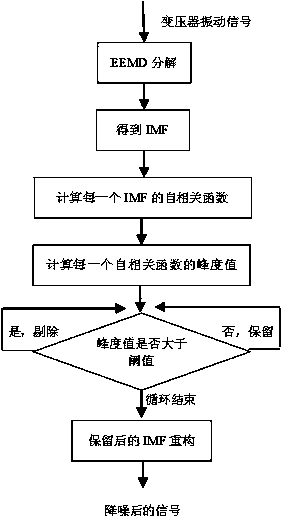Transformer vibration signal de-noising method based on EEMD kurtosis threshold value
A vibration signal and transformer technology, which is applied in the field of transformer vibration signal noise reduction, can solve the problems that no solution is given, the distinction can only be judged by humans, and there are useful signals
- Summary
- Abstract
- Description
- Claims
- Application Information
AI Technical Summary
Problems solved by technology
Method used
Image
Examples
Embodiment 1
[0063] A transformer vibration signal denoising method based on EEMD kurtosis threshold, the method includes the following steps: first, EEMD decomposition is performed on the collected transformer vibration signal, and then the autocorrelation function is calculated for each eigenmode function IMF and its Kurtosis coefficient, and then use the threshold to distinguish these intrinsic mode functions IMF, and then remove the noise signal.
Embodiment 2
[0065] According to the transformer vibration signal noise reduction method based on the EEMD kurtosis threshold described in Embodiment 1, the described EEMD decomposition of the signal utilizes the characteristics of the uniform distribution of the white noise spectrum, so that the white noise signal is automatically averaged after EMD decomposition Decompose to different time scales; due to the zero-mean characteristic of white noise, the IMF after multiple decompositions is averaged and the noise effect is completely eliminated, that is, the final IMF component without aliasing effect is obtained. The specific algorithm is as follows :
[0066] Step 1: In the original signal join in White noise with subzero mean and constant standard deviation ;
[0067] (1);
[0068] Step 2: Add white noise to the signal Perform EMD decomposition to get Intrinsic mode function IMF components and a 1 residual component ,
[0069] ...
Embodiment 3
[0077] According to the transformer vibration signal noise reduction method based on the EEMD kurtosis threshold described in Embodiment 1, the autocorrelation function of the random signal reflects the degree of correlation between the signal and itself at different time points, and is a statistical measure in the time domain method, which is defined as:
[0078] (6),
[0079] (7),
[0080] In the formula: is the time interval, Indicates the value of the correlation function between the signal and itself at the same time. Obviously, this value is the largest for any random signal; the autocorrelation function is a function of the signal interval, and the interval has positive and negative intervals, so the length is signal, there is The autocorrelation function values describe the similarity of different signal intervals, and also reflect the symmetry of the autocorrelation function.
PUM
 Login to View More
Login to View More Abstract
Description
Claims
Application Information
 Login to View More
Login to View More - R&D
- Intellectual Property
- Life Sciences
- Materials
- Tech Scout
- Unparalleled Data Quality
- Higher Quality Content
- 60% Fewer Hallucinations
Browse by: Latest US Patents, China's latest patents, Technical Efficacy Thesaurus, Application Domain, Technology Topic, Popular Technical Reports.
© 2025 PatSnap. All rights reserved.Legal|Privacy policy|Modern Slavery Act Transparency Statement|Sitemap|About US| Contact US: help@patsnap.com



